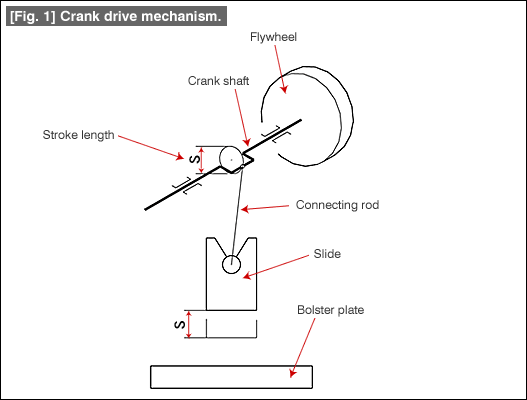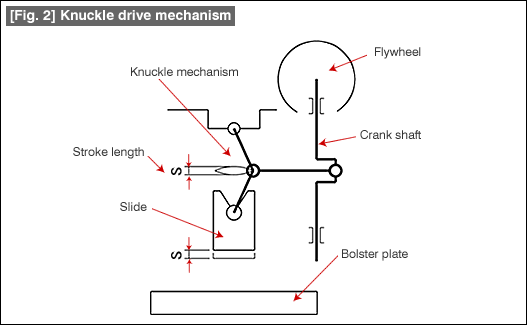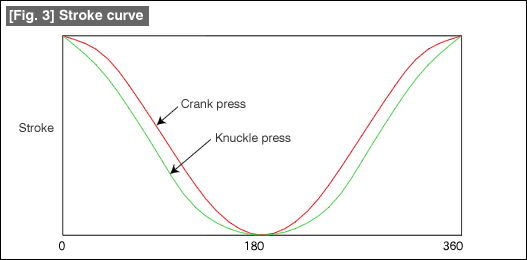#049 Relationship Between Press Machine and Die (7) Drive Mechanisms of Press Machines
The crank type press machines (crank presses) that are used most frequently among all types of press machines have a structure such as that shown in Fig. 1.

The structure of this type is simple and this type is used widely because it is easy to manufacture. There is a form called eccentric shaft among crank shafts, but recently there is no particular preference being given to any shape of the shaft (because the completeness of the press machine becomes high and since it is possible to confirm that the required functions are being satisfied by checking the specifications).
Another typical mechanism is the knuckle mechanism in a press machine. This type of structure is shown in Fig. 2. This is a machine in which the slide is being driven by adding a link to the crank mechanism.

The reason why press machines are manufactured by changing the mechanism is the stroke curve shown in Fig. 3.

In a crank press, as soon as the slide reaches the bottom dead center, the returning step is stared immediately. In press forming, if there is a slight pressing time at the bottom dead center, there is the characteristic that the formed shape becomes stable. Modifications are made to the drive mechanism in order to exploit this characteristic. The stroke curve of the knuckle mechanism in Fig. 3 becomes more gradual near the bottom dead center compared the stroke curve of the crank mechanism, from which it can be seen that the pressing time is longer than in the case of the crank press. It can be said that this mechanism is one that was prepared for obtaining this forming curve.
Because of this characteristic of the knuckle press is used frequently in the case of forming that includes crushing or when countermeasures are to be taken against spring back of bending, etc. Its disadvantages are that it is difficult to prepare long strokes, and that, since the number of joints becomes large, the overall gap is likely to become large, etc. However, high precision modified press machines of this type are being manufactured at present.
Apart from the above, there is also a type called link press. This type is prepared with the intention of obtaining gradual movement at the bottom dead center and fast returning. In addition, by changing the mechanical details, there are machines in which changes have been made in the motor. This type is called a servo motor press. The press machine of the mechanical type assumes a constant rotation of the crank shaft within one stroke. If it is possible to change the rotation of the shaft, it will be possible to prepare any stroke curve freely. Perhaps the manufacturing of molds may become somewhat easier.
- #167 Problems in Punching and their Countermeasures (6) Scrap Processing in Punching
- #166 Problems in Punching and their Countermeasures (5) Trimming of Drawn and Shaped Parts
- #165 Problems in Punching and their Countermeasures (4) Scrap Clogging in Punching
- #164 Problems in Punching and their Countermeasures (3) Bending and Twisting of Narrow Punched Parts
- #163 Problems in Punching and their Countermeasures (2) Bending due to Punching



